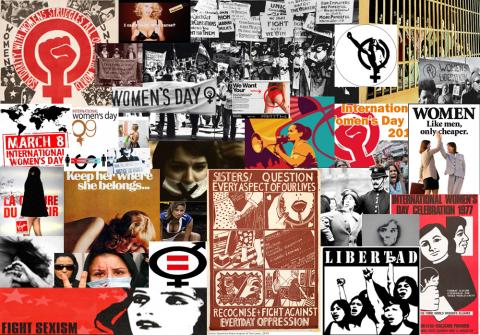Still a long way from equality

To mark International Women’s Day 2012, the European Women’s Lobby has put together a briefing on gender equality in the EU. The briefing covers politics, pay, employment, violence against women, women's representation in the media and the multiple discrimination many women face. Highlights from the briefing are below, and the full paper is embedded at the bottom of this piece.
Women in decision-making
- At the moment, less than 35% of Members of the EUROPEAN PARLIAMENT are women, up from 30% in 2004 and only 16% in 1979, but slightly less than after the elections of 2009.(1)
- In 2011, 24% of Members of national parliaments were women, one percentage point higher than in 2005. The percentage is above 40 % in the Netherlands and Sweden and below 10 % in Malta and Hungary.
- 26% of members of national GOVERNEMENTS are women. The figure has increased from 22% in 2005.
- Only 3.2% of the presidents of the 100 largest publicly quoted European COMPANIES are women.
- The proportion of women in the boards of the largest publicly listed companies in the EU was 13.7% in January 2012. In Sweden, Finland and Latvia, more than 25 % of board members of large companies are female, while in Luxembourg, Cyprus, Hungary and Malta, this share is under 6%.
- In 16 European countries, men occupy more than 90% of UNIVERSITY headships.
Women’s economic independence
- The average hourly PAY GAP between women and men in the EU is 16.4%. Women earn more than 25% less than men in Estonia, Austria and in Czech Republic.
- The EU average EMPLOYMENT rate is around 75% for men but 62.5% for women (between 20 and 64 yrs).
- The employment rate of women (between 25 and 49 yrs) with children under the age of 12 drops by 11.4 percentage points whereas it increases by 8.5 percentage points for men in the same situation.
- European women are four times more likely to work PART-TIME: 31.5% of the women work part-time in the EU-27 versus 8.3% of men.
- Women count for two-thirds of the ‘inactive’ population (63 million persons between 25-64 years) due mainly to unpaid care responsibilities.
- One third (34%) of SINGLE-PARENT families in Europe, 80-90% of which are headed by women, are living in poverty.
Violence against women
- 45% of women in Europe have suffered from men’s violence.(2)
- In Europe, 7 women die every day from MALE DOMESTIC VIOLENCE.(3)
- Women employees are still significantly more exposed to WORKPLACE BULLYING than their male colleagues and that the difference is even greater in the case of sexual harassment: more than three times as many female as male employees report having experienced sexual harassment in the previous 12 months.
- In an online study, 99% of women said they experienced some form of STREET HARASSMENT, including: leering, honking and whistling, sexist comment, making vulgar gestures, saying sexually explicit comments, kissing noises, following, blocking path, sexual touching or grabbing, masturbating, assaulting. (4)
- In France, 205 women are RAPED every day, only 2% of perpetrators are condemned, only 1 victim out of 10 will report to the police, 74% of rapes are committed by someone the victim knows.
- The right to ABORT is still denied or restricted in four EU Member States (Malta, Cyprus, Ireland and Poland)
Media and women
- Only 26% of subjects in European NEWS are female.
- Women are central to a news story 12% of the time.
- Women make up 22% of experts and 21% of spokespersons in the news.
- 10% of POLITICIANS in the news in Europe are female.
- Women are nearly twice as likely to appear as news subjects in stories on social issues than in stories on politics or governments.
- In European news, women are three times as likely as men to be identified in terms of their family status.
- Women represent 27% of employees or professionals shown in ADVERTS, but 60% of those portrayed doing housework or looking after children.
- Adverts showing boys place them outside of the house 85% of the time; those featuring girls place them more than half of the time inside the home.
- In adverts, women are more than twice as likely as men to be portrayed in (semi-)nudity.
- Up to 34 years old, women represent 79% of TV PRESENTERS; over 50, they are only 7%.
Multiple discrimination
- Highly-educated MIGRANT women born outside the EU are twice as likely to be employed in low-skill jobs as EU-born and native-born women with the same level of education.
- Twice as many ethnic minority women compared with ethnic minority men experienced discrimination on the basis of gender. So, minority women are vulnerable to ‘multiple discrimination’ on the basis of their ethnicity background and their gender.
- Over half of all women with DISABILITIES have experienced physical abuse, compared to one third of women without disabilities.
- In the UK, ROMANI and Travellers face the most serious disadvantages of all ethnic minority groups with a much shorter life expectancy, low income and poor access to finance; their children have high mortality rates and the lowest educational attainment. (5)
{jathumbnailoff}
(1) European Parliament website data extracted 2012.
(2) Everyday Violence – How Women and Men Experience Sexual and Physical Danger’, Elizabeth Stanko; Pandora; 1990; cited in Women’s Aid
(3) Psytel, Estimation de la mortalité liée aux violences conjugales en Europe, Programme Daphne III.
(4) stopstreetharassment.com, 2008
(5) Communities and Local Governments, United Kingdom 2011, in Presentation of Romany and Travellers by Federation of Cale/Kale, Manouches, Romany & Sinti Women, February 2011.
European Women's Lobby Press Briefing Women in the EU - Some Facts and Figures 2012
Image top: Eadaoin O'Sullivan
